Throughout the whole history of mankind, just a few traditions, customs and living cultures have survived over time, one of them is the Qeswachaka Inca suspension bridge.
An ancient relic built by the Inca culture, a sample of advanced engineering, is the Q’eswachaka Inca bridge, which is renewed annually by four local Andean communities.
Do you want to learn more about this awesome Inca rope bridge? Come along with us, we’re Inkayni Peru Tours, to discover the legacy behind the last Inca bridge.
WHAT IS THE QESWACHAKA INCA BRIDGE?
It is an Inca bridge hanging over the Apurimac River, made of Highland Puna Grass ropes, tied with a special ” Q’eswa ” technique. Also, it’s a living vestige and one of the most impressive achievements of the Incas that is still used by highland dwellers.
IMPORTANCE OF THE QUESHUACHACA BRIDGE
As the Great Inca Trail or “Qhapaq Ñan” was built, problems arose. The network of Inca roads, which spans almost 40,000 kilometres, crosses diverse terrain, including the Andes Mountains.
To overcome obstacles like canyons and cliffs, the Incas pioneered the construction of suspension bridges. These Inca bridges not only solved logistical problems but also facilitated expansion and connection between distant towns and land. The construction of Qeswachaka Inca Bridge is attributed to the Inca Pachacuteq 600 years ago.
After the fall of the Inca civilisation, the Qeshuachaka last Inca bridge remained in use for centuries, functioning as an Andean road system for the surrounding communities.
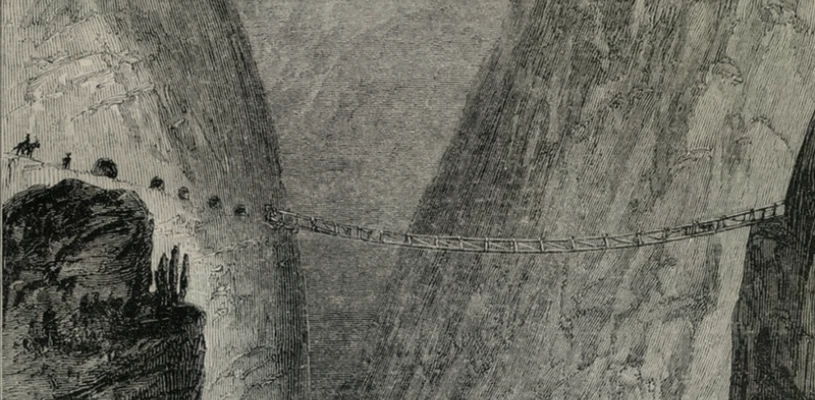
Qeswachaka Bridge
CHARACTERISTICS OF THE QUESHUACHACA BRIDGE
As the only Inca bridge in use that survived modern times, it was recognised by UNESCO as an Intangible Cultural Heritage of Humanity in December 2013.
Likewise, specialists consider this bridge to be one of the most outstanding examples of engineering in all of history, which constitutes one of the valuable legacies of the extensive network of pre-Hispanic Inca roads of the Tahuantinsuyo, known as Qhapaq Ñan.
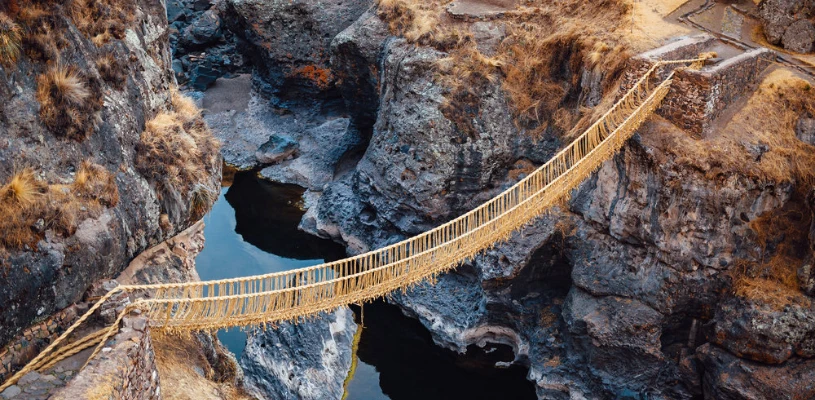
Qeswachaka the last Inca Bridge
WHERE IS QUESWACHAKA?
It is located in the region of Cusco, in the province of Canas, in the district of Quehue.
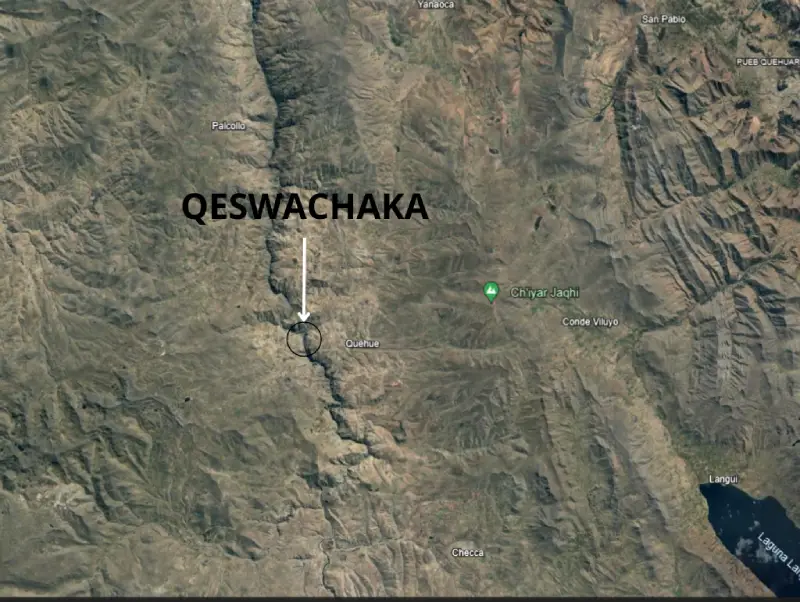
Where is the Qeswachaka Inca suspension bridge located?
HOW HIGH IS QUESWACHAKA?
The Q’eswachaka Inca bridge is roughly 3,794 m / 12,447 ft ASL.
ACCLIMATISATION FOR VISITING THE QUESHUACHACA BRIDGE
You might notice that the Queswachaca Bridge is located at a higher altitude than Cusco City and these 300 metres of elevation gain will make the difference. Therefore, if you do not experience altitude sickness or soroche in Cusco, it is likely that you will not encounter acclimatisation problems when visiting the Q’eswachaka Inca bridge.
Furthermore, the altitude of Qeswachaka is different from the Rainbow Mountain and Humantay Lake’s altitude.
For these reasons, we advise the following advice:
- Staying hydrated helps to oxygenate your body as it adapts to higher altitudes.
- Get used to the altitude for at least one day in Cusco.
- Chew coca leaves.
- Avoid alcoholic beverages because they dehydrate your body.
- Get adequate resting time.
ALTITUDE SICKNESS – ACUTE MOUNTAIN SICKNESS
Known as mountain sickness or soroche, it occurs when the body has difficulty adjusting to climatic variations due to low oxygen pressure at high altitudes.
Symptoms of altitude sickness:
- Headache.
- Dizziness.
- Difficulty sleeping.
- Lack of appetite.
- Nausea or vomiting.
- Rapid pulse (heart rate).
- Shortness of breath.
HOW IS THE WEATHER IN QESWACHAKA?
It has a temperate-cold climate and its temperature varies between 16°C – 2°C. It has two well-defined seasons, which I describe below:
DRY SEASON
It runs from April to November. The lack of rain is common in this season, but there are unexpected showers at altitudes higher than 4000 m / 13123 ft ASL.
WET SEASON
It runs from November to March. You’ll experience pouring or hammering down rain through the Andes.
CLIMATE OF QESWACHAKA MONTHLY:
JANUARY
- Pros: Cusco and Qeswachaca have fewer visitors this month, the prices are cheaper and the mountains are greener.
- Cons: Lot of rain that makes tours wet and trails slippery. It can also make visibility difficult.
FEBRUARY
- Pros: Even fewer tourists target visiting Cusco this month.
- Cons: It’s the month with the highest rain levels in the entire year.
MARCH
- Pros: The rains begin to dissipate and are occasional, reducing the risk of landslides and other hazards. Also, tour prices are still kept lower than in other months.
- Cons: Occasional showers can wet you.
APRIL
- Pros: This is the best month to visit the Q’eswachaka Inca Bridge because the weather is better and the dirt roads are safer to drive on.
- Cons: Prices of services begin to increase as months pass.
MAY
- Pros: Fantastic weather that allows you to do anything you plan.
- Cons: Cusco starts to look very crowded.
JUNE
- Pros: The weather is warm, and the rainy season has finished. Also, this is the month of restoration of the Q‘eswachaka Inca bridge.
- Cons: It is the month with the highest number of hikers.
JULY
- Pros: The weather is still favourable, with sunny days but cool nights. You will be able to get the best photos and enjoy the lush scenery.
- Cons: High tour prices.
AUGUST
- Pros: The temperature ranges from 26°C – 29°C, the weather is warm and it is an ideal month.
- Cons: Tour prices and tourist numbers are still relatively high.
SEPTEMBER
- Pros: The weather is mild, temperatures vary between 25°C – 28°C, still a good month to visit.
- Cons: Occasional rains begin this month.
OCTOBER
- Pros: The temperature averages 21°C, the day remains warm.
- Cons: Cloudy and windy days are common.
NOVEMBER
- Pros: The days are temperate at 22°C.
- Cons: The rainy season starts.
DECEMBER
- Pros: The weather is mild and humid. The influx of tourists is no longer crowded.
- Cons: Rainfall is daily, which can cause difficulties on dirt or paved roads.
WHAT IS THE LENGTH OF THE QUESWACHACA BRIDGE?
The Qeswachaka Inca bridge is 28 metres long and only 1.2 metres wide, suspended some 30 metres above the Apurimac River.

Reconstruction of Qeswachaka
WHAT DOES QESWACHAKA MEAN?
“Q’eswachaka” comes from the Quechua language and consists of two parts:
- “Q’eswa”, which means “rope” or “tied”.
- “Chaka” means “bridge”.
So “Q’eswachaca Inca bridge” translates as “tied bridge”.
HOW FAR IS QUESHUACHACA FROM CUSCO?
The distance between this Inca bridge and Cusco is approximately 156 kilometres. That means around 3 hours and 45 minutes of driving.
HISTORY OF QUESHUACHACA
The chroniclers affirm that the Incas used the suspension bridges to extend their dominance to new lands, control towns and people that already belonged to the Inca empire and the subjugation of new ones.
The objectives at the time of building the bridges were both offensive and defensive. With the arrival of the Spaniards, these same bridges facilitated the conquering of the Inca civilisation. Although Inca bridges were also burned to stop the Spaniards’ expansion, it was impossible to stop them.
The Inca suspension bridges were built following these characteristics:
- Thick braided natural ropes form the floor and handrails.
- Stone abutments anchor the cables on both sides of the bridge and vertical ties between the main cables and the handrails.
Comparing modern bridges with the Q’eswachaka Inca bridge, we find a difference: the main cables used to build the bridge’s suspension not only serve as support but also as a footbridge.
Today, Qeswachaka the last Inca bridge is considered a sacred expression of the communities’ connection to nature, tradition and heritage.
The Quechua-speaking communities of Huinchiri, Chaupibanda, Choccayhua and Ccollana Quehue see it as a means of strengthening their social ties and not simply as a means of communication.

Construction of the Qeswachaka Inca suspension bridge
RENOVATION OF Q’ESWACHAKA INCA BRIDGE
Renewal and working together are values deeply rooted in the Andean cosmovision. For this reason, some architectural reconstructions are made.
That is why the renovation of the Qeswachaka Inca suspension bridge is not only a testimony of our culture; on the other way around, it marks the beginning of a new year in the high Andes.
Likewise, renovating the Qeswachaca Inca suspension bridge lasts 4 days and is scheduled for every June.
FIRST DAY
Before they start working, at dawn, people worship Apu Quinsallallawi. Then, the inhabitants of the four communities seek large amounts of “Ichu”, which is a type of grass growing in the high Andes.
Once the necessary amount of Ichu has been collected, the women weave this solid grass into thin ropes about 70 metres long to form the ropes of the Inca bridge. On the other hand, men are in charge of joining these thin ropes end to end and then braiding them to have thick strong natural ropes.
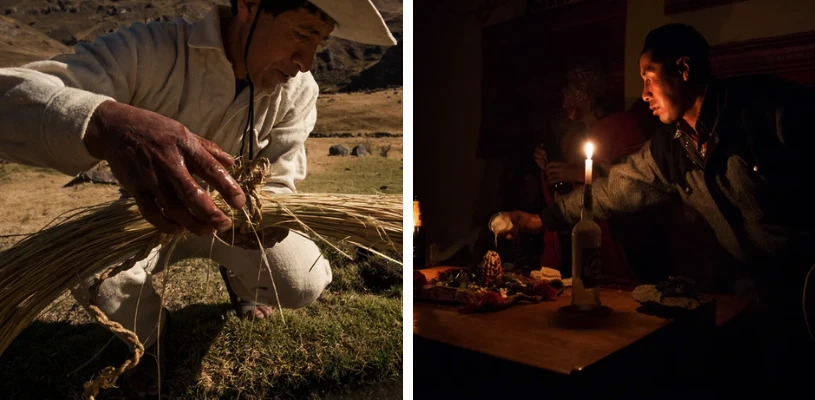
Man collecting Ichu from the mountain
SECOND DAY
The old Inca bridge structure is removed with the stone nails that support them as well. People place the first four ropes belonging to the new bridge.
The construction stages of the new bridge are supervised by two “Chakaruwaq”, who are expert artisans in weaving techniques passed down from generation to generation.
This work method is inspired by the Mink’a labour, which is a collective work for the benefit of the whole community, practised by the Incas.
By tradition, only men can participate laying of the new bridge, while the women are in charge of weaving the ropes.
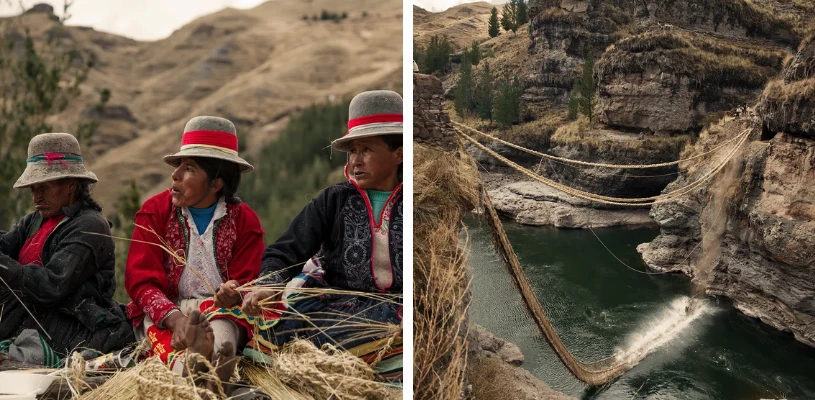
On the second day of the renovation of the Qeswachaka Inca suspension bridge
THIRD DAY
Two experts in the technique of weaving bridges lead the whole process whilst villagers conclude the assembly of the handrails and the surfaces of the bridge where the communities will cross.
The reconstruction of the Queshuachaca bridge is thus completed, without the use of any machine or tool, resorting exclusively to Ichu and human skill.
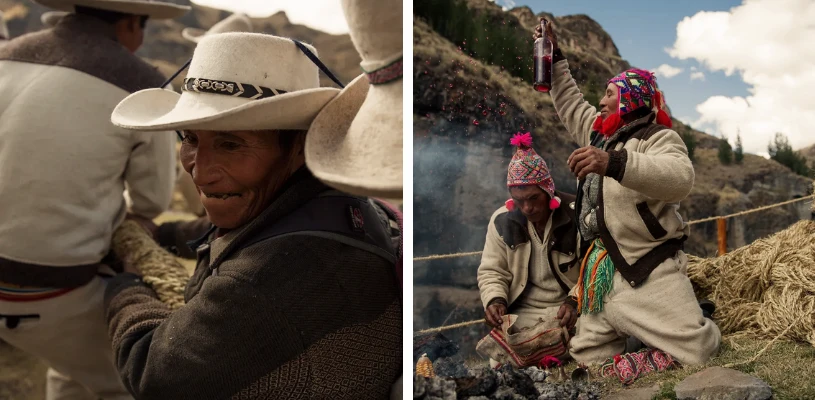
The renovation of the Queshuachaca bridge is finished.
FOURTH DAY
The leaders of each community give speeches and thank everyone. Everything culminates in a feast, accompanied by music and traditional dances that fill the atmosphere with joy and celebration.
The Queshuachaca suspension bridge connects these four communities literally and figuratively. Rebuilding is a tradition that has been maintained for hundreds of years and passed down from generation to generation.
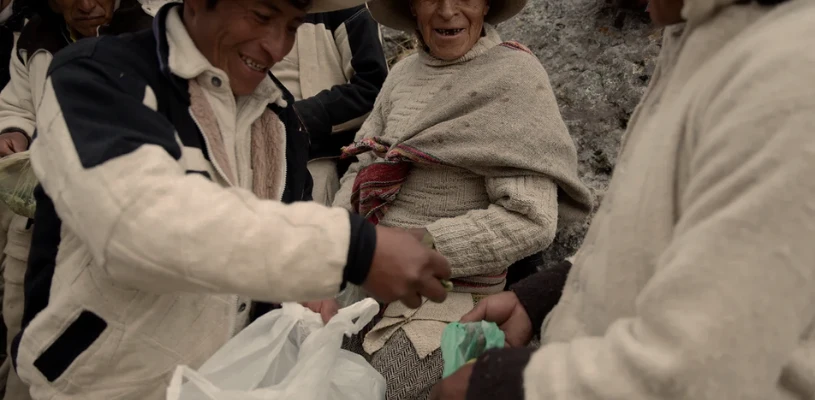
Qeswachaka suspension bridge – the end.
HOW TO GET TO THE INCA BRIDGE?
ON YOUR OWN
It is not very difficult to get to the Qeswachaka Inca bridge, but if you go on your own, consider the following:
Step 1: Getting to Combapata
- Buses to Combapata leave from Huayruropata Avenue, costing around 10 soles / 3 USD. Consider that the journey lasts 3 hours.
Step 2: Getting to Yanaoca
- From Combapata – take a bus to Yanaoca. The ticket costs around 8 soles / 2,52 USD, and you will pass through awe-inspiring views along the way.
Step 3: Reach Quehue
- From Yanaoca, you can take a taxi towards Quehue. Consider that walking from Yanaoca to Quehue will take about 4 hours.
HIRING A TRAVEL AGENCY SERVICE
On the other hand, Inkayni Peru Tours offers you an interesting full-day tour where you will not only visit the Qeswachaka Inca suspension bridge, but you will be able to visit the four lagoons that are on the way:
POMACANCHI
Pomacanchi Lake is located between Pomacanchi and Acopía districts, at an altitude of 3,669 m.a.s.l. It is approximately 104 km away from Cusco.
The weather of Pomacanchi Lake ranges between 9ºC and 15ºC, very rich in flora and fauna. It is also part of the four Andean lakes circuit which is very popular with national and foreign tourists.
ACOPIA
This lake is also part of the circuit of the four bodies of water, which is located beside Acopia town.
This lake is characterized by its fauna. Here, you will observe the presence of wildlife.
ASNAQOCHA
Asnaqocha Lake, which means stinky lake, has abundant algae that when in contact with the sun rays produce a strong and nauseating smell.
PAMPAMARCA OR TUNGASUCA
Pampamarca Lake is home to a wide variety of wildlife such as Flamengoes and ducks, due to the abundance of cattails that surround it.
It is a freshwater lake where sport fishing is practised commonly.
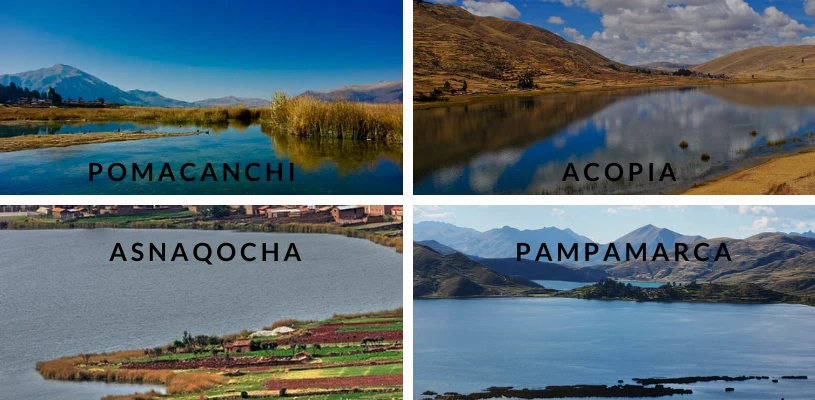
The four lakes near Q’eswachaka Inca bridge
CAN YOU GO TO QUESHUACHACA WITHOUT A GUIDE?
Of course, you can. Visiting the Qeswachaka Inca suspension bridge does not require a professional guide service, but we hardly recommend one.
Guides are knowledgeable and have recent information about Qeswachaka, as well as they can provide additional information, such as history, the bridge’s construction, and show the fauna and flora around the area.
It’s recommended to have a guide to deal with any inconvenience or problem that may arise, such as altitude sickness or concerns.
HOW DIFFICULT IS THE QESWACHAKA INCA BRIDGE HIKE?
It’s light due to its length. However, it’s very uncommon to suffer altitude sickness when people don’t push themselves to the limits.
HOW LONG IS THE HIKE TO QESWACHAKA BRIDGE?
The hike is short because a dirt road is passing by. Transportation will drop you off beside the bridge, then just 10 minutes of walking is needed.
Upon arrival, you will see an information panel at the entrance with relevant information about the Queswachaca hanging bridge.
The path doesn’t present any significant difficulty; you will only descend some stairs before reaching good views.
CLOTHING FOR VISITING QESWACHAKA INCA BRIDGE?
It will depend on the season in which you decide to visit the hanging bridge of Queshuachaca. But what is essential is the following:
- Long and short-sleeved T-shirt made of synthetic fibre.
- Fleece jacket.
- Waterproof jacket.
- Trekking pants.
- Trekking shoes.
- Sun hat.
- Sunglasses.
WHAT TO TAKE TO QESWACHAKA?
For this tour and other full-day tours:
- Personal documents (ID or passport).
- Daypack.
- Sunscreen (SPF 50+).
- Camera.
- Extra money.
COMMON QUESTIONS:
WHY VISIT THE QESWACHAKA BRIDGE?
Indeed. Qeswachaka is the last living Inca bridge, which had witnessed Inca people crossing the Apurimac River. Furthermore, it’s a tangible symbol of ancestral traditions, a connection to the glorious past of the Incas and a source of community pride, and considered the last remaining Inca bridge.
If you are in Cusco do not forget to visit this wonderful place and learn a little more about the Incas and their history.
HOW HIGH IS THE Q’ESWACHACA BRIDGE?
This bridge lies at 3,794 m / 12,447 ft ASL. It is not too high compared to other tourist attractions.

CAN I VISIT THE QESWACHAKA BRIDGE ALL YEAR ROUND?
Yes, you can. Qeswachaka is open all year round, but there are some recommended seasons to visit, such as the dry season.
CAN I HEAD TO QESWACHAKA WITHOUT BOOKING A TOUR?
Yes, you can. The visit to the hanging bridge of Qeswachaka does not necessarily require a tour, but we do recommend choosing one. Because booking with a travel agency makes it easier and more comfortable and the cost is not high.
IS IT POSSIBLE TO SWIM IN THE APURIMAC RIVER?
Difficult to respond to. The Apuirimac River is wild in the rainy season, then, you can not even try to swim there. Nevertheless, this river is calm in some sections during the rainy season.
ARE THERE BATHROOMS NEAR Q’ESWACHAKA BRIDGE?
Yes, there are restrooms. They are located near the entrance of the bridge and cost 1 sol.
CAN I FLY MY DRONE ABOVE QESWACHAKA?
Yes, but you need to coordinate with the guide and the local people. Then, they’ll accept your petition without major concerns.
IS THERE CELLPHONE RECEPTION IN Q’ESWACHAKA CRIDGE?
Sincerely, there is no cellphone reception in the area.
CAN I CAMP NEAR QESWACHAKA BRIDGE?
Yes, you can camp. There are no signed camping areas, but you can choose a flat space to set up your tent.
IS THE QESWACHAKA BRIDGE TOUR SUITABLE FOR ALL AGES?
Yes, it is, as it is not difficult and the altitude is not high. Q’eswachaka is one of the best options to visit with your family.
Consider that Cusco is not only Inca architecture, nor exuberant nature; on the other hand, it’s living culture, traditions and customs.
Now that you have learned much more about this iconic Inca bridge, considered the last Inca suspension bridge, what are you waiting for to be there? The Qeswachaca Bridge is a sample of our ancestors’ skill, ingenuity and companionship.
Dare! We are Inkayni Peru Tours, your finest option! We have the best tour of Qeswachaka. Book now!







